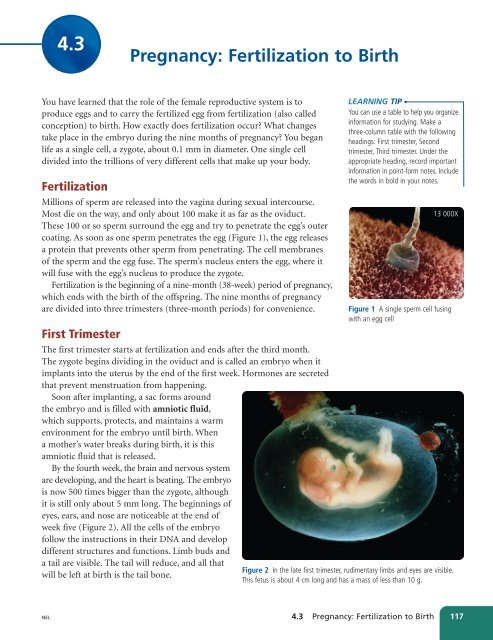Unit A Reproduction
Unit A Reproduction
Unit A Reproduction
Create successful ePaper yourself
Turn your PDF publications into a flip-book with our unique Google optimized e-Paper software.
4.3<br />
Pregnancy: Fertilization to Birth<br />
You have learned that the role of the female reproductive system is to<br />
produce eggs and to carry the fertilized egg from fertilization (also called<br />
conception) to birth. How exactly does fertilization occur? What changes<br />
take place in the embryo during the nine months of pregnancy? You began<br />
life as a single cell, a zygote, about 0.1 mm in diameter. One single cell<br />
divided into the trillions of very different cells that make up your body.<br />
Fertilization<br />
Millions of sperm are released into the vagina during sexual intercourse.<br />
Most die on the way, and only about 100 make it as far as the oviduct.<br />
These 100 or so sperm surround the egg and try to penetrate the egg’s outer<br />
coating. As soon as one sperm penetrates the egg (Figure 1), the egg releases<br />
a protein that prevents other sperm from penetrating. The cell membranes<br />
of the sperm and the egg fuse. The sperm’s nucleus enters the egg, where it<br />
will fuse with the egg’s nucleus to produce the zygote.<br />
Fertilization is the beginning of a nine-month (38-week) period of pregnancy,<br />
which ends with the birth of the offspring. The nine months of pregnancy<br />
are divided into three trimesters (three-month periods) for convenience.<br />
First Trimester<br />
The first trimester starts at fertilization and ends after the third month.<br />
The zygote begins dividing in the oviduct and is called an embryo when it<br />
implants into the uterus by the end of the first week. Hormones are secreted<br />
that prevent menstruation from happening.<br />
Soon after implanting, a sac forms around<br />
the embryo and is filled with amniotic fluid,<br />
which supports, protects, and maintains a warm<br />
environment for the embryo until birth. When<br />
a mother’s water breaks during birth, it is this<br />
amniotic fluid that is released.<br />
By the fourth week, the brain and nervous system<br />
are developing, and the heart is beating. The embryo<br />
is now 500 times bigger than the zygote, although<br />
it is still only about 5 mm long. The beginnings of<br />
eyes, ears, and nose are noticeable at the end of<br />
week five (Figure 2). All the cells of the embryo<br />
follow the instructions in their DNA and develop<br />
different structures and functions. Limb buds and<br />
a tail are visible. The tail will reduce, and all that<br />
will be left at birth is the tail bone.<br />
LEARNING TIP<br />
You can use a table to help you organize<br />
information for studying. Make a<br />
three-column table with the following<br />
headings: First trimester, Second<br />
trimester, Third trimester. Under the<br />
appropriate heading, record important<br />
information in point-form notes. Include<br />
the words in bold in your notes.<br />
13 000X<br />
Figure 1 A single sperm cell fusing<br />
with an egg cell<br />
Figure 2 In the late first trimester, rudimentary limbs and eyes are visible.<br />
This fetus is about 4 cm long and has a mass of less than 10 g.<br />
NEL<br />
4.3 Pregnancy: Fertilization to Birth 117

















